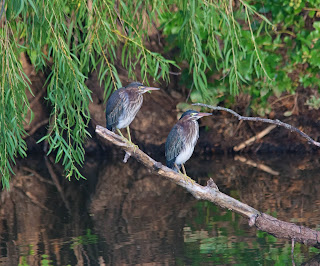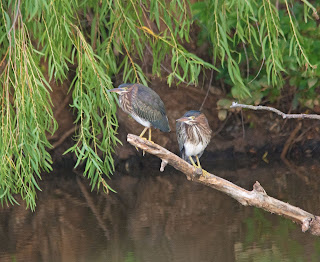Translate
Sunday, August 25, 2019
Monday, August 19, 2019
Final Green Heron Photos and Mississippi Kites Versus Northern Mockingbird
Green Heron 2 out of 3
081119
0730-0811/81-82 F/heat index 87 F/partly cloudy/SE-6/75-7 % RH/29.89-29.91 Hg and rising
Clutch 3 Green Herons are growing well and are flighted. Their fledging has been rapid, considering that they were in the shaded area of the northeast segment of Heron Cove.
Green Heron 1 of 3
Green Heron 2 and 3 of 3
Solitary Sandpiper
081219
0722-0902/82-88 F/heat index 91 F/clear/SSW-10/67-62% RH/29.82-29.79 Hg and steady
Daily photos of young Green Herons will show their rapid growth while flight gets stronger.
The Solitary Sandpiper was located at Veteran's Memorial jetty on the north side. They usually prefer
to be on fresh water mudflats, edges of brushy ponds or ditches, and even on fields with shallow water. This behavior is slightly out of character, yet they commonly come to Boomer Lake area during fall migration.
2 out of 3 Green Heron Fledglings
081419
0727-0904/77-80 F/variable clouds/NW-7/74-72% RH/30.01-30.05 Hg and rising
Every day a few more downy feathers disappear from the Green Heron heads.
Mississippi Kite Vocalizing to Comrades
Hunting Area Insects Like Dragonflies
and Cicadas
081719
0720-0938/82-89 F/heat index 92/var. clouds to partly cloudy/ESE-10/66-61% RH/29.84-29.89 Hg and rising
Mississippi Kite (In Tree)
Northern Mockingbird (In Air)
Ditto, View 2
Mississippi Kite
081819
1040-1202/73-85 F/partly cloudy/S-12/80-74% RH/29.84-29.89 Hg and rising
Writer was out at 0720 and rain was imminent. The furthest I got was to Heron Cove, which was well checked. There were eight Yellow Warblers seen there, which is quite a bit for one area. During the second excursion, no others were found and I went beyond the east side restrooms.
Highlights observed were the Mississippi Kites that were hawking insects from both the power poles and bald cypress trees. The above kite had been harassed by a Northern Mockingbird, as this territory area is his.
Third shot of this kite showed it searching for larger insects like cicadas and dragonflies. When the insects are captured, the kite rapidly pulls off a wing or two to keep them within grasp so they can be consumed on the wing.
Sunday, August 18, 2019
Sunday, August 11, 2019
Monday, August 5, 2019
Birding On a Shoestring: Cheyenne Bottoms, Kansas
Forster's Tern, non-breeding
Forster's Tern, nonbreeding 2
Forster's Tern, nonbreeding 3
Franklin's Gulls
Franklin's Gulls 2
Black Tern (Left) and Franklin's Gull (Right)
Black Tern
Black Tern 2
Franklin's Gull
072819
1300-1700/ partly cloudy/windy, 25-30 mph
After lunchtime was interesting, as there was a lot of water in the marshes, as well as large numbers of birds. Since it was so windy, it appeared that many of the birds would be lying low, which the normal ones were. However, when it came to Barn and Cliff Swallows, they were taking everything in stride from the air, of course.
Much of the sun was in the wrong direction when we drove toward the first bird-filled marshes, making them difficult to identify due to glare. Most of the seasonal birds, including White-faced Ibis, Great Blue Heron, Great Egret and Snowy Egret were there, as well as both Long- and Short-billed Dowitchers, and many of the other usual shorebird suspects.
We also saw the head of a young male buck with short fuzzy antlers in the water, swimming toward shore, then deviating in our direction to follow the shoreline. It almost seemed that he was unable to gain land purchase, but it didn't make sense that he could not. It appeared that he was doing his best to keep his head up, and through observation, he may have been walking on the bottom, as well as swimming. He finally passed us in the water, as we stopped the car to not make him fearful of us.
There were good representations of American Avocets and White-faced Ibis, where we could actually clearly see the white faces. One ibis found a prize, which may have been a frog, and he was doing his best to keep the other birds from stealing it. He dropped it several times, and finally managed to eat it.
Passing other ponds, we observed Pied-billed Grebes, Mallards, and Blue-winged Teal. It was almost like certain species had their own ponds, but it most likely had to do with water depth.
We'd also see a few groups of Franklin's Gulls, an occasional Black Tern, as well as Forster's Terns. The further along we got, we discovered that more representatives of these birds were caught in a wind tunnel. They were flapping their wings, yet not going anywhere, staying fairly stationary. Unless these birds managed to deviate to the right, they stayed within this odd cycle of events. There were eventually Great White Pelicans in the area who were in the water, as well as a few of the Franklin's Gulls and an occasional Ring-billed Gull. A Black-Crowned Night-Heron was also discovered on the tail end of this melee, but it managed to break free of the wind prison.
Many, many more ponds were observed and the wind seemed to lessen in the central part of the refuge. Large numbers of the previously mentioned herons were seen, as well as the White-faced Ibis. It was a most remarkable collection of birds. The further inland we were, a few songbirds turned up, as well as Turkey Vultures and Red-tailed Hawks.
We held out hopes for an American Bittern but we could have missed it, though there was some good habitat.
for more on the adventure:
https://debhirt.blogspot.com/2019/08/birding-on-shoestring-cheyenne-bottoms.html
https://debhirt.blogspot.com/2019/08/birding-on-shoestring-quivira-national.html
Sunday, August 4, 2019
Birding On a Shoestring: Cheyenne Bottoms Preserve
Female Dickcissel
Male Dickcissel
Bank Swallows
Grasshopper Sparrow 1
Grasshopper Sparrow 2
072819 early to late morning
The following morning we took a jaunt to the Nature Conservancy's Cheyenne Bottoms Preserve, which was a prelude to Cheyenne Bottoms.
The Preserve includes 7700 acres, which has some shallow marshes less than a foot deep, deeper marshes up to several feet, and some priceless tall grass habitat.
Many of the birds observed were the Red-winged Blackbird, Dickcissel, Western Meadowlark, Blue-winged Teal, Red-tailed Hawk, and the ubiquitous White-faced Ibis. Around the reservoir were large numbers of Bank Swallows and Great-tailed Grackles, all seeking insects.
Many areas like these are usually closed to the public, so this wonderful find was a treasure to traverse for the morning.
for more on the adventure:
https://debhirt.blogspot.com/2019/08/birding-on-shoestring-quivira-national.html
https://debhirt.blogspot.com/2019/08/birding-on-shoestring-cheyenne-bottoms_5.html
Saturday, August 3, 2019
Birding On a Shoestring: Quivira National Wildlife Refuge, Kansas
Black-necked Stilt
Long-billed Dowitcher
Assorted Shorebirds #1
Snowy Plover
White-rumped Sandpiper
Baird's Sandpiper
White-rumped Sandpiper
Assorted Shorebirds #2
Assorted Shorebirds #3
Greater Yellowlegs (Left)
Killdeer (Right)
Greater Yellowlegs (Center)
Baird's Sandpiper (Right)
White-rumped Sandpiper (Left)
Northern Cliff Swallow
Ruddy Duck and Ducklings
Blue-winged Teal (Front)
Immature and Juvenile American Coot (Center and Rear)
American Coot Adult (Left)
Recently Hatched American Coot (Right)
adult male Black-necked Stilt (Rear)
Juvenile Black-necked Stilts ( Center)
adult female possibly on nest (Front)
072719
Taking about five hours, my birding buddy and I arrived at Quivira around 1130ish. Several area residents had informed us at pitstops that there had been plenty of rain this year, so we could expect some wonderful birds. This information was taken to heart, and the more observed, the better it got.
Primed for this adventure, my eyes had been on weather conditions, past and present. It was a given that this adventure was a little too early for both the Red Knot and Buff-breasted Sandpiper, but it was a solid time for the many resident breeding birds and their offspring. There was no disappointment.
The first thing we did was visit the tower area, which had good views of Barn Swallows, Black-necked Stilts in flight that were constantly calling, Great Egret, Great Blue Heron, Spotted Sandpiper, and more.
Eventually making it to Little Salt Marsh, the numbers and species of shorebirds was thrilling, even though many of the most common migrants were there. Just seeing them in their natural state, both on the shore and foraging in the shallow water brought back memories of home in Maine.
Though my hunt for the Bobolink was unsuccessful, a fabulous photo of the Northern Cliff Swallow was unparalleled. There are hopes to return to another part of KS at a later time when the Bobolink and other target birds will be more accessible.
We drove through the Big Salt Marsh area, where were encountered many water birds, which included the above family of Black-necked Stilts, and took a short walking tour at Migrant's Mile Nature Trail. This was a former marsh that had a little water. Sampling my first sand plums, we heard the Common Yellowthroat, and semi-observed a few others.
The prairie grass area also netted the Northern Cliff Swallow. Many other grassland birds, like the meadowlark and Dickcissels were heard there.
Juvenile American Coots, Blue-winged Teal, Black-necked Stilts, and Ruddy Ducks were somewhat unexpected and most welcome. Never had I observed the young of these species.
Once we arrived, we never left until it was time to resettle round the Cheyenne Bottoms area in Barton County. A short stop was made just prior to the Kansas Wetlands Education Center closing for the day, where we semi-solidified plus for Sunday. Stay tuned for the Cheyenne Bottoms and Cheyenne Bottoms Preserve adventure.
for more on the adventure:
https://debhirt.blogspot.com/2019/08/birding-on-shoestring-cheyenne-bottoms_5.html
https://debhirt.blogspot.com/2019/08/birding-on-shoestring-cheyenne-bottoms.html
Subscribe to:
Posts (Atom)






































